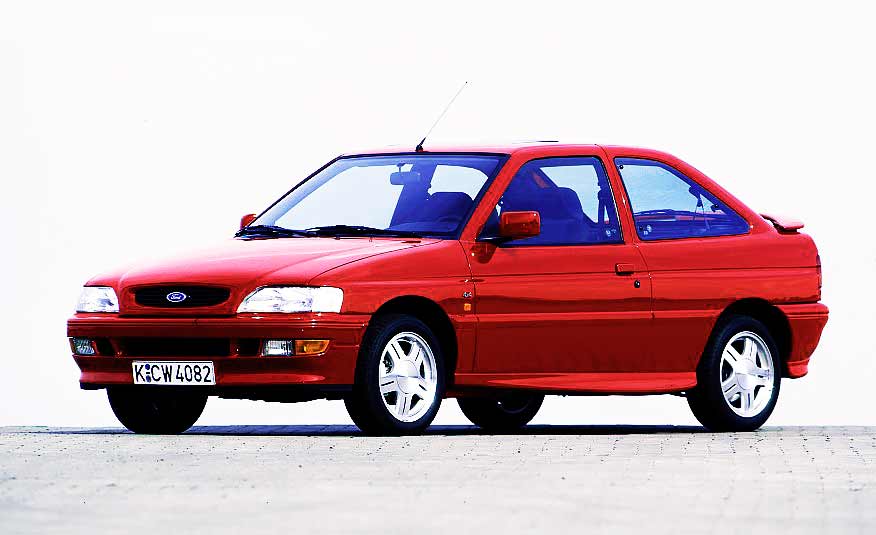
Red shift, blue blood. Ford’s latest Focus RS, the company’s quickest-ever road car, comes from a long line of compact Fords with RS badges. We gather the Escort and Focus bloodline together at the historic Dagenham factory, and drive them all. Words John Simister. Photography James Lipman.
Ford RS: Escort to Focus. John Simister heads to deepest Dagenham.
FOCUS RS MEETS THE ANCESTORS
Two letters. What do they mean? Depends on the car manufacturer and its predilections. Most famously they appear on fast Porsches (Rennsport), showing a bias towards the racetrack; and on fast Fords (Rallye Sport), with rallying the image to be portrayed. Not that RS-badged Fords shied away from racetrack action as the tag grew in scope.
Ford has just launched its latest Focus RS, hailed by the popular press as the most perfect hot hatchback on offer today. Maybe, maybe not; it depends on your taste in such cars, and how firm you like your ride. But it is undeniably a mighty thing, with 345bhp – 345! – fed through all four wheels and a powersliding ‘drift’ mode on offer at the press of a button. It will do 165mph, passing 62mph just 4.7 seconds into a headlong rush towards a maximum speed higher than that of any previous quantity-production European Ford. We think of it as a European Ford, anyway.
Ford doesn’t. It’s a world car, with RS and ST models nowadays developed by Ford Performance with outposts all over the globe. The Focus RS was engineered primarily in Europe, true, but under the control of an American. Tyrone Johnson is one of the keenest, most articulate engineers I have ever met. In a long but fascinating presentation of how the Mk3 Focus RS came to be, not a single utterance of management-speak or fast-car cliché passed his lips.
So here we are at Dagenham, in a Ford plant nowadays devoted to building diesel engines but steeped in auto-history. The shunting engines have been here since the 1960s, the original Thames-side factory building since 1931, both long before the re-routed A13 dual carriageway marched across the middle of the Dagenham Estate on its concrete pillars.
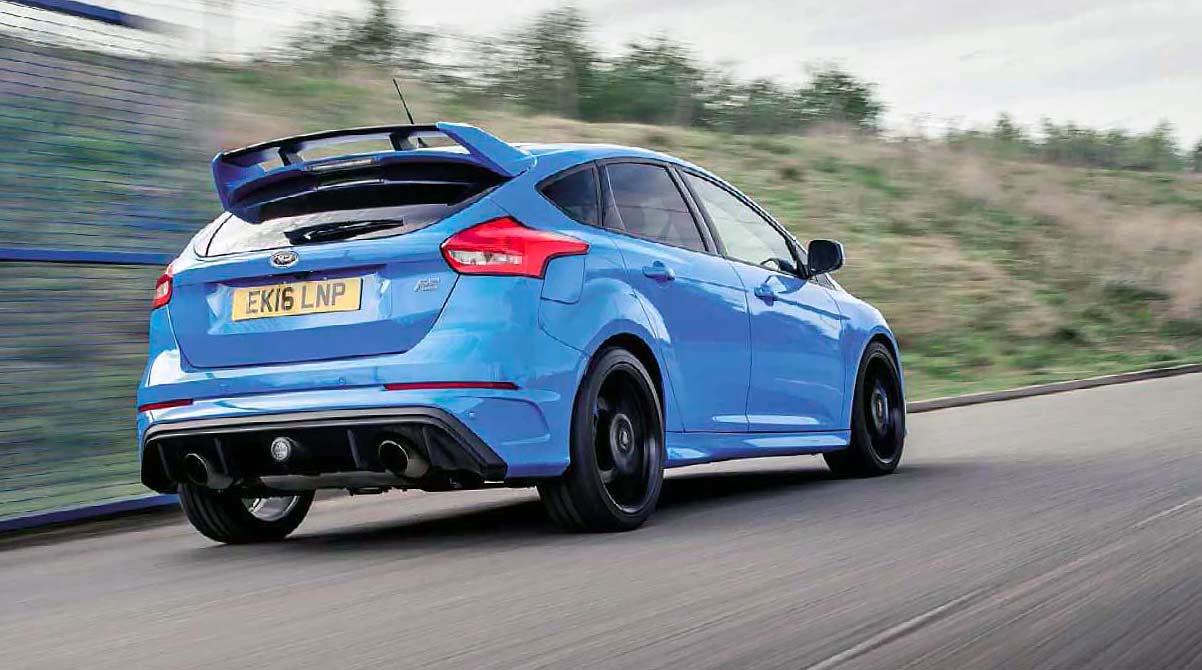
Compact Fords with RS badges
Lined up are the new RS and the milestone models of its ancestors, the compact category of RS-badged Fords. The newer, the bluer: the Mk3 RS is in livid Nitrous Blue, almost the colour of a motorway sign but with a faint mica fleck, while the Mk2 is in darker Performance Blue metallic. Next to it is a Mk1, in Imperial Blue with a purpler tinge than the Mk2’s hue. Actually, this isn’t any old Mk1. It’s the very first of 4501 examples, all of them the same colour. Identically painted is its predecessor, the much-loved RS Cosworth version of the otherwise unloved Mk4 Escort. It has four-wheel drive like its newest descendant, but in this case with the longitudinal engine that goes with the fact that this is an Escort bodyshell atop an abbreviated Sierra Cosworth platform.
Now, on our reverse temporal journey, the blueness dissipates. Our Mk3 Escort, badged RS Turbo and the first forced-induction RS production model, has dark blue fade-out side stripes on its standard-issue white paintwork. Our Mk2 is also white, the Diamond White finish of most of these homologation-special, Cosworth BDA-engined RS1800s. And finally we have the first of the line, the Escort RS1600 in Sebring Red, also BDA-powered.
Most of us think that the RS story starts here. Certainly the story is neater that way. But the truth is slightly different, and it involves Germany. We’ll come to it later.
BEGINNINGS: THE REAR-DRIVE YEARS
Ford Performance is today’s creator of fast Fords, a result of the Blue Oval’s latest worldwide reorganisation. It incorporates the former Special Vehicle Engineering (SVE) operation, formed in 1980 and originally based at Dunton, Essex, and its US and German counterparts. The previous Focus RSs came from SVE, by then known also as Team RS, but its first project was the revitalising of the Capri for the dinosaur coupé’s last few years, followed by some of the XR-badged cars.
SVE was itself a reincarnation of what we’d now call a skunkworks: AVO, or Advanced Vehicle Operations, which existed from 1970 until 1975, when it was sidelined after economic fallout from the Yom Kippur war. AVO was based at Aveley, Essex, just a few powerslides away from Dagenham, and was the brainchild of Ford of Britain’s PR supremo, Walter Hayes. Earlier fruits of his publicity-seeking brain had been the GT40 and, with FoB’s competitions chief Henry Taylor, the Escort Twin-Cam.
Most of the Twin-Cams were assembled at Ford’s Halewood factory, where their unique parts and special build needs caused quite a lot of disruption. So Hayes’ idea was for a catch-all facility to develop and build all of Ford’s sporting models and projects. Initially it was run by Ray Horrocks, who later went to British Leyland, along with Henry Taylor, Bob Howe in planning and Rod Mansfield as chief development engineer, the last of whom later set up SVE. Stuart Turner took over after Horrocks left, masterminding AVO from the competition department at Boreham.
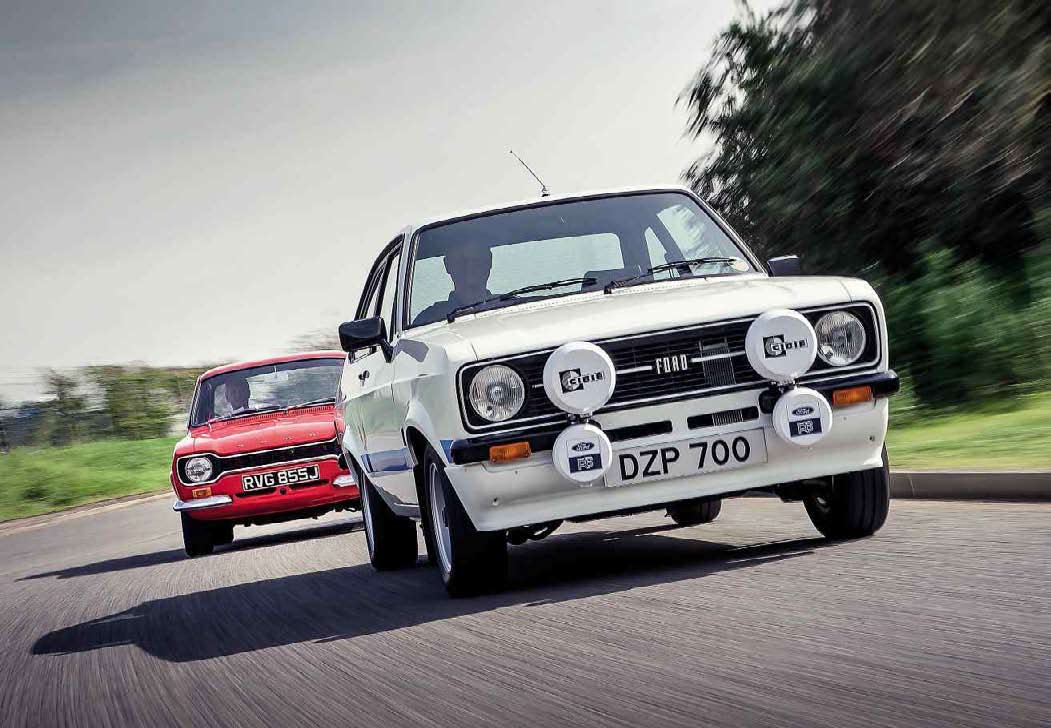
1970 Ford Escort RS1600 and 1975 Ford Escort RS1800
AVO’s first project was the Escort RS1600. It was intended as a low-volume car for motor sport, and its productionised version of the Cosworth BDA (Belt Drive Anglia, because that’s where the roots of its cylinder block lay) was arguably the first twin-cam, 16-valve engine to be fitted to a production car. AVO worked hard to make it civilised for the road, overcoming problems such as huge oil consumption following the conversion from dry to wet sump. ‘The cambox would occasionally fill up with oil,’ recalled Mansfield years later, ‘so there’d be a lot of smoke.’
There is no such blue haze around our RS1600 today. It’s a 23,000-mile, 1970-built jewel with a special place in AVO history. Shortly after the RS1600, Ford launched the Escort Mexico to celebrate the Escort’s win in the World Cup Rally. The Mexico was effectively an RS1600 with an 86bhp pushrod ‘Kent’ engine. But Ford hadn’t actually completed any Mexicos in time for the launch advertisement’s photoshoot.
‘So they used this car,’ says owner Mike Gattrell. ‘It was originally going to be white, as the chassis plate confirms, but it was plucked from the line and painted red, with handpainted Mexico stripes. In the ad it’s posed in front of a shipping container; “We brought it back from Mexico”, it says. Then it was Roger Clark’s runaround for a while. I’m trying to get the original Essex registration number back.’
First impression? It’s tiny. And extremely pretty, as two-door Mk1s are, especially with lightly flared front arches, wide wheels, front quarter-bumpers and a blacked-out grille. It was restored 20 years ago but not too deeply, so it wears an authentic patina. The cosy black cabin features a proper RS steering wheel, fronting an instrument panel stuffed with two big dials and four small ones, the plastichrome peeling from their rims. ‘I might get them rechromed,’ ponders Mike. I’d leave it as it is.
It’s a snorty, rorty thing, the air-filter box not entirely masking the gulps of the two Weber 40 DCOEs. Once past parking-speed heaviness the steering becomes light and super-precise, the gateway to that intuitively predictable, carefree chuckability that is an early Escort’s dynamic signature. A similar oily precision is felt when snicking through the gears.
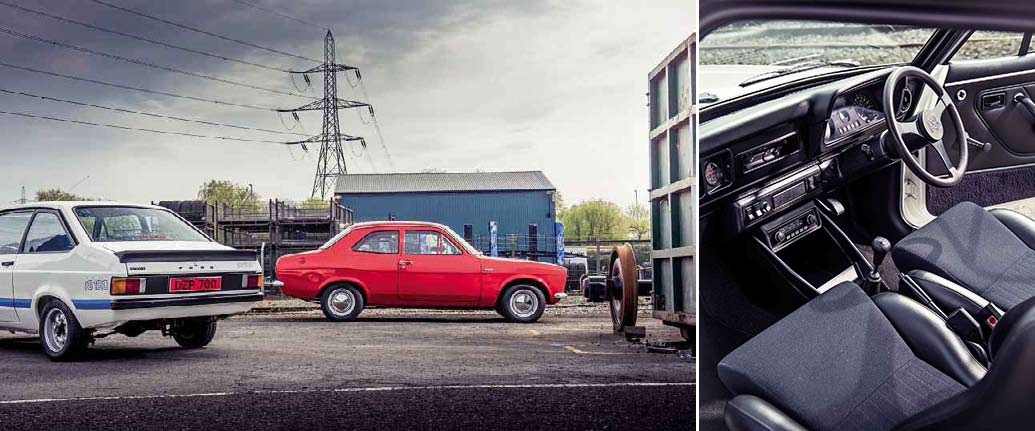
Left and facing page. In Britain, at least, it all started with the simple, leaf-sprung, rear-wheel-drive, BDA-engined Escort. Red Mk1 used to be Roger Clark’s runaround; white Mk2 is the only RS1800 to be sold new in the Irish Republic.
The engine has plenty of torque low down, the impression heightened by the Escort’s lightness (it weighs just over half as much as the latest Focus RS, shockingly), but right now it’s hard to get it delivered cleanly as Mike’s brand-new carburettors aren’t optimally set up yet. Once past 3500rpm or so, though, this first British RS really flies. It’s the 1970s equivalent of a really good hot hatchback, saloon body shape notwithstanding.
So the RS1800 should feel similar, if more extreme. After all, beneath its bigger, squarer body, a Mk2 Escort is almost exactly the same as a Mk1. However, strange happenings were afoot in the world of RS Fords in the post-Energy Crisis world. Homologation specials were still needed as the base for a continued rallying campaign – indeed, RS1800s continued at the top level of International rallying right up to 1981 – but AVO was being wound down and Ford was not keen to encourage sales of the specialist, expensive-to-build RS1800 when the more profitable, more civilised and equally quick Ford RS2000 (Pinto engine, ‘droop-snoot’ nose) was also on offer.
As revealed in March 1975, the RS1800 featured a larger version of the BDA engine, with a new aluminium block bored out to 1834cc. Strangely, though, it produced less power (115bhp) than its 1601cc predecessor (120bhp) although torque had risen, along with the complete car’s weight. Why was this? Instead of two sidedraught Webers the RS1800 made do with a single downdraught one, Ford hoping that buyers would then avail themselves of the extensive Rallye Sport options list to reinstate the optimum number of venturis.
This retrograde step contrasted with the enhancements elsewhere, such as the Capri front suspension and a tougher crossmember. As with the Mk1, the bodyshell was strengthened and radius rods added to the rear suspension. The first 25 or so examples were built at Aveley on the bases of Halewood-built Escort 1600 Sports, but that changed from January 1976. Ford had by then added an RS Mexico to the range, built at Saarlouis, Germany, and effectively an RS1800 but with a single-cam Pinto-type engine. So it made sense to use that as the base instead, as it already had the other enhanced parts.
Eighty Saarlouis-sourced RS1800s were finished at Aveley while AVO faded away, the last in September 1977 with, in total, just 110 RS1800s built. All were right-hand drive; all but one were registered in the UK.
Our car here is the one that wasn’t. DZP 700 went to its first owner in the Irish Republic on 1 October 1976, but buying it was a battle. Ford initially supplied a Mexico, hoping it would do the job and circumvent the lack of RS knowledge among Ireland’s Ford dealerships, but Friel’s Garage in County Donegal persevered and eventually the RS arrived, complete with luxury Custom Pack.

Clockwise from facing page. RS1800 features the archetypal RS steering wheel; its aluminium-block engine originally had a single carburettor; RS1600 has a fine cluster of dials and earlier RS wheel; its BDA engine is based on an iron block.
Today it has the Weber 45DCOE carburettors it deserves, and a few other modifications such as Bilstein dampers, lowered rear suspension, a bigger-bore exhaust system and a Sierra-type five-speed gearbox, all administered in the late 1990s. Peter Christie bought it three years ago, and enjoys the fact that the four lower ratios mimic the RS originals while fifth gives the senses some respite at motorway speeds.
Not much, it must be said. Also on the modlist is a World Cup crossmember, much prized by Escort rallyists. One of its features is that the engine is bolted solidly to it, so there’s quite a vibratory din in the cabin to go with the 150bhp made possible by the engine’s freer breathing. This is a properly fast, hard-edged machine, surely most of the way to credible rally specification. I’m sitting low and laid back, tapping through the gears via short, solid lever movements and the dabbing of a firm, decisive clutch. It revs with a torrent of vigour, snorting its way out of bends with a tail-flourish, a paragon of precision. You just know that on a gravel rally stage it would be utterly hilarious, Webers gobbling, stones flying.
‘YOU JUST KNOW THAT ON A GRAVEL RALLY STAGE IT WOULD BE UTTERLY HILARIOUS, WEBERS GOBBLING, STONES FLYING’
‘THE STEERING BECOMES LIGHT AND SUPER-PRECISE, THE GATEWAY TO AN EARLY ESCORT’S CAREFREE CHUCKABILITY’
TECHNICAL DATA Ford Escort RS1600 (launched 1970)
Engine 1601cc four-cylinder, iron block, aluminium head, 16-valve DOHC, two Weber 40DCOE carburettors
Power 120bhp @ 6500rpm
Torque 112lb ft @ 4000rpm
Transmission Four-speed gearbox, rear-wheel drive
Suspension Front: MacPherson struts, coil springs, track control arms, anti-roll bar. Rear: live axle, leaf springs, radius rods, telescopic dampers
Steering rack and pinion
Brakes Discs front, drums rear
Tyres 165 R13
Weight 785kg
Performance Top speed 113mph. 0-60mph 8.3sec
TECHNICAL DATA Ford Escort RS1800 (in standard form, launched 1975)
Engine 1834cc four-cylinder, aluminium block and head, 16-valve DOHC, Weber 32/36 DGV twin-choke carburettor
Power 115bhp @ 6000rpm
Torque 120 b ft @ 4000rpm
Transmission Four-speed gearbox, rear-wheel-drive Suspension Front: MacPherson struts, coil springs, track control arms, anti-roll bar. Rear: live axle, leaf springs, radius rods, telescopic dampers
Steering rack and pinion
Brakes Discs front, drums rear
Tyres 175/70 R13
Weight 914kg
Performance Top speed 115mph. 0-60mph 9.0sec
BRING ON THE TURBOCHARGERS
And then Ford Escorts went front-wheel drive. Had to; it was the way of the world. The first warmed-over Mk3 was the XR3, a dynamically unpleasant device until SVE sorted out the suspension and gave it fuel injection to make the XR3i. Ford’s German motor sport arm meanwhile came up with the RS1600i, a homologation special with different suspension tweaks and solid instead of hydraulic tappets for the transverse CVH (Compound Valve-angle Hemi) engine, making it even harsher at high revs.
The RS1600i wasn’t a great success, so SVE took over and tried a different tack. The result was the RS Turbo, back with hydraulic tappets but featuring a Garrett T3 turbocharger, fully mapped engine management and power up to 130bhp from the XR3i’s 105. A Ferguson-designed, viscous-coupled, limitedslip differential, its manufacture a joint venture between GKN and ZF, helped channel the power to the road, and radius rods helped locate the front track control arms better than the anti-roll bar could on its own.
So here is our first turbocharged RS, setting the template for all the ‘proper’ ones to follow. Body-colouring the bumpers, the single-bar front grille, the rear spoiler and the wheelarch extensions lends it a modern air not replicated in the cabin, although the Recaro seats are superb. The forced induction smooths the engine’s power delivery, making this a sweetly spinning CVH as well as a punchy one. There’s surprisingly little delay in the turbo’s response, and this Escort can be hustled along with gusto.

1984 Ford Escort RS Turbo and 1992 Ford Escort RS Cosworth
That limited-slip differential does some strange things, though. It inverts the normal front-wheel-drive behaviour by pulling the nose onto a tighter line under power, in a novel re-interpretation of power oversteer. There’s the pull and tug of torque-steer on an imperfect road, too, but you soon adjust to its ways and find yourself having a terrific time. In its dynamics it resembles a primordial Honda Integra Type R, which is no bad thing.
Five thousand RS Turbos like this one emerged from the Saarlouis factory before a 1986 facelift rubbed away the quirks and, in the process, spoiled the surprisingly supple ride. Last November an RS Turbo near-identical to Steve Perkins’ example here, but with just 5568 miles recorded, made £60,188 at auction. ‘Unbelievable,’ says Steve, who has owned his Escort for 25 years.

Above and left Final RS Escorts gained turbos, setting the tone for Focuses to follow. RS Turbo facia was one of the last to have a central radio speaker.
Out with the Mk3, in with the Mk4. A year after the 1990 launch of Ford’s most critically panned model range ever came a pair of warmed-over versions of the Mk4 Escort, reprising both the XR3i and the RS2000 names. But there was little Rallye Sport in that RS; the real thing came a year later, in 1992. The SVE-developed Escort RS Cosworth featured the Cosworth YB engine of the about-to-be-obsolete Sierra RS Cosworth, as well as its floorpan (slightly shortened) and its latterly added four-wheel drive system.
Ian Callum, later aligned with Aston Martin and nowadays Jaguar’s design chief, styled the beefed-up body with its spoilers, slots and louvres and its bulging arches, pulled rearwards in the case of the back ones, and Karmann built it. The engine, still based on a Pinto block, gained power over its Sierra application, but initially it was boosted by an outsize turbocharger for reasons of homologation. In 1994, the required 2500 examples having been built, Ford downsized the turbo from a Garrett T35 to a T25. This had 60% less rotational inertia but retained enough air-compressing capacity for the road car’s 227bhp.
The idea was to banish the original version’s yawning turbo lag and make the Escort Cosworth a properly entertaining road car. Which it did. Our example here, owned by Ford as are all the Focus RSs, has a full-force shove from low revs which continues far up the rev range and through all the gears. The YB motor is not known for its silken delivery but this example is the smoothest I’ve tried, the sonic edges filed away from its low-speed burble. In place of the meatily shifting Borg- Warner gearbox of the early Sierra Cosworths is Ford’s MT75 unit, remarkable for combining a hefty torque capacity with a light, easy shift redolent of, well, an RS1600’s.

Clockwise from above. Escort Cosworth’s engine is mounted longitudinally, unlike that of lesser Mk4 Escorts; its cabin has white dials, airbag steering wheel and burgeoning complexity; RS Turbo engine bay is dominated by intercooler pipe.
You sit low and firmly clamped in huggy Recaros, at one with a machine which feels both solidly weighty and pointily agile. Its balance is mostly that of a rear-drive car but without the uncertainty of a boost-induced tail-wag; just precise, minutely adjustable responses tainted only by an unnatural lightness to the steering’s on-centre response. The view aft is dominated by the T-shape of that vast rear spoiler, while those seats and a panel of extra gauges help distract your senses from the cabin’s mundane roots.
This, then, is an Escort only in name and in some visuals. And after the Escort Cosworth, the RS trail went cold for a while. Until 2002, in fact, when SVE’s rebranding as Team RS, headed by Dutchman Jost Capito, brought us the first, and long-promised, Focus RS.
‘IN ITS HANDLING DYNAMICS THE RS TURBO RESEMBLES A PRIMORDIAL HONDA INTEGRA TYPE R, WHICH IS NO BAD THING’
TECHNICAL DATA Ford Escort RS Turbo (launched 1984)
Engine 1597cc transversely mounted four-cylinder, iron block, aluminium head, 8-valve SOHC, Bosch KE-jetronic fuel injection, Garrett T3 turbocharger
Power 130bhp @ 6000rpm
Torque 133lb ft @ 3000rpm
Transmission Five-speed gearbox, front-wheel drive
Suspension Front: MacPherson struts, coil springs, transverse links triangulated with tie bars, anti-roll bar. Rear: MacPherson struts, coil springs, transverse and trailing links, anti-roll bar
Steering rack and pinion
Brakes Ventilated discs front, drums rear
Tyres 195/50 VR15
Weight 971kg
Performance Top speed 126mph. 0-60mph 7.8sec
TECHNICAL DATA Ford Escort RS Cosworth (launched 1992)
Engine 1993cc longitudinally mounted four-cylinder, iron block, aluminium head, 16-valve DOHC, Weber-Marelli engine management, Garrett T25 turbocharger
Power 227bhp @ 5750rpm
Torque 221lb ft @ 2500rpm
Transmission Five-speed gearbox, four-wheel drive
Suspension Front: MacPherson struts, coil springs, transverse links triangulated with tie bars, anti-roll bar. Rear: semi-trailing arms, coil springs, telescopic dampers, anti-roll bar
Steering rack and pinion, power-assisted
Brakes Ventilated discs all round
Tyres 225/45 ZR16
Weight 1275kg
Performance Top speed 140mph. 0-62mph 6.1sec
RS LINE BACK IN FOCUS
Ford’s Focus was a watershed car. After the debacle of the Mk4 Escort, Ford gave power back to the engineers, and the accountants no longer ruled. The first evidence of this was the excellent Mondeo, followed by effective salvage jobs on the Escort and Fiesta and the launch of the highly entertaining Ka; but 1998’s Focus, with its ‘control blade’ rear suspension, eager engines and detailed attention to friction and bush construction in the suspension, blew its mainstream hatchback rivals into history.
Its styling was pretty striking, too, all exaggerated flank-sculpting and a dashboard of intersecting curves. A warmed-up version, dubbed ST as were (and are) other fast Fords, appeared in 2001 while the RS was still being developed from the concept car shown a year earlier. Ford’s World Rally Championship operation, run by Malcolm Wilson from his workshop in Cumbria, helped with development, and the result was conceptually rather similar to the Escort RS Turbo: front-wheel-drive and a limited-slip differential.
This was a surprise. The pundits expected four-wheel drive, but Ford believed that the front wheels alone were more than able to handle the 212bhp generated by the 2.0-litre ‘Duratec’ engine with its surprisingly high (for a turbo) 10.0:1 compression ratio. The Quaife ATB (Automatic Torque-Biasing) differential was the key to that belief. Hold that thought.
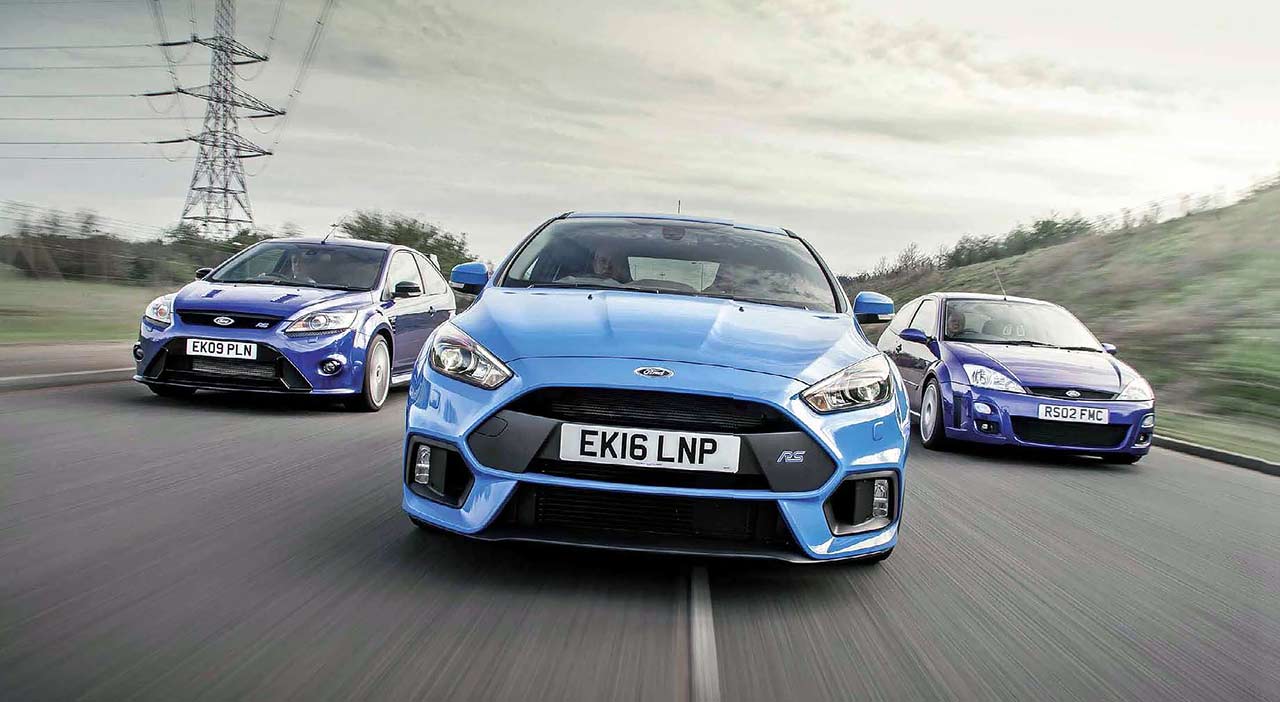
Ford Focus RS Mk2 and Ford Focus RS Mk1 vs. Ford Focus RS Mk3
That power output sounds quite gentle by today’s standards, but the aftermarket tuners quickly found ways to ramp it up, maybe even double it. With that modesty of muscle came commendably restrained looks: a deep front valance, pulled-out wheelarches and wide OZ wheels the main RS identifiers. Inside, blueness rampaged over the seat and door inserts and sections of the steering wheel’s rim, including a centre-point marker. There was also a starter button, meant to evoke a competition car’s fitment; the spring-loaded start position remained in the ignition switch, but it no longer worked. Cheaper than engineering a new switch, we were told.
The suspension’s uprating included Sachs racing dampers, but one of the first things you notice is the civilised, light-footed ride. The next is a trace of turbo lag, despite the ample off-boost compression, but thereafter the feeling under the accelerator pedal is one of linear, mechanical connection rather than attachment by an elastic band. Closing the throttle triggers a chirrup from the turbo’s wastegate; very old-school.
This is a deliciously eager engine, full of torque delivered with a deep, meaty burble. And that ATB differential? I remember some of these Focus RSs, including the one I drove on the press launch near WRC HQ, tugging this way and that as I powered out of a bend, others having a more determined pull towards the bend’s apex after a late-braking entry. Either way, the nakedness of the Focus RS’s dynamics, with no electronics to smother them, drew me deeply into the drive and it was massively entertaining. But, as you’d expect, making the engine deliver more power made the drive a lot more unruly. Then the pleasure was gone.
Hindsight, and the benefit of driving the next two Focus RSs, has put the Mk1 into context. Today it feels especially light and compact, free of inertia, cajoling you into throwing it around as you might the Escort RS1600. There’s a low-friction feel to its every movement, and a fabulously firm response to pressure on its brake pedal. Yes, if I accelerate hard out of a tight corner in second gear it feels as if it wants to trip over the outside front wheel, but slightly straightening the super-crisp steering or easing the accelerator sorts it out instantly. This car just wants to play. I’d have one in a heartbeat.
And then the Focus got fat. The Mk2 model, launched in 2009 after another long wait, gained nearly 200kg over its predecessor. It also gained an extra cylinder and half a litre of engine capacity, plus a massive power jump to 301bhp. Other gains included colours other than blue, including a lurid metallic lime green which adorned the first example I drove on the press launch, this time in the Alpes Maritimes. Something it did not gain was four-wheel drive, once again much speculated-upon given the power increase but rejected by Jost Capito.
‘We’ll make 305bhp work with front-wheel drive,’ he had said, ‘or there will be no Focus RS.’ The first Mk2 Focus RS prototypes did have four-wheel drive, but they lacked the edgy, agile feel Capito wanted and they weighed too much. Reporting on the new RS in The Independent, I wrote: ‘He thinks the messages a powerful front-wheel-drive car sends through its steering wheel, far from being a corruption of directional purity, help you feel the power and the grip. The trick is not to let that spill over into the tugging and fighting that blighted the first Focus RS.
‘So it’s Revo-Knuckle to the rescue. This is not a big-fisted superhero from Marvel Comics but a clever front suspension system in which the steerable hub is separated from the suspension strut, which itself no longer turns. Similar to the system in the Renault-sport Mégane, it ensures the engine’s considerable torque – 325lb ft all the way from 2300 to 4500rpm – doesn’t try to pull the front wheels in unwanted directions when grip is uneven.’
Seven years later (it feels less), I’m trying this second-version Focus RS, its body muscled-up over the regular article’s in much the same way as the Mk1’s, again. After the previous generation’s extravagant curves and swages, the Mk2 is straight-laced and sober outside and in, RS addenda excepted. The dashboard is a simple slab with an excess of silver plastic embellishment, and the whole car feels the more substantial artefact that it is.
But, goodness me, it’s fast. It snicks under six seconds to the metrically mandated 62mph (100km/h), but seemingly never gets near to running out of puff. The five-cylinder sound is a deep, crisp-edged, half-octave harmonic with added firecrackers on every upshift, and you can pile on the pounds-foot almost ludicrously early in a fast corner. The Mk1’s Quaife differential features here, too, but this time the Revo-Knuckle lets it do its best without collateral histrionics. Thrust isn’t strong enough a word. Eruption is better.
For all that, though, this isn’t as subtle and satisfying a drive as the Mk1 offers. It’s more brute force and bluster, more a case of activating the controls than feeling your way through them. And then Ford finished the production with 500 examples of the RS 500 version, all satin black and featuring 345bhp. Even the RevoKnuckle might find it hard to handle that.
Now there’s a new one, the latest in this rather fabulous line of fast Fords. Its 2.3-litre Ecoboost engine – back to four cylinders – is similar to the 2.0-litre unit found in several European Fords but it most closely resembles that of the latest Mustang. To cope with the extra output, up to 347lb ft of torque being available in 15-second overboosted bursts, the cylinder head is made of tougher aluminium and the block’s cast liners are high-tensile castings.
Tasty factual snippets abound with this latest RS, all told with relish by Tyrone Johnson. It does, finally, have four-wheel drive, using a GKN torque-vectoring system which sends around 70% of the torque to the rear wheels unless circumstances dictate otherwise. Of that 70%, up to all of it can be sent entirely to one rear wheel if needed. However, on a long straight the Focus becomes front-wheel drive, with the clutch controlling drive to the rear held at a ‘kiss point’, ready to engage.
As for the engine, late in the testing programme the engineers found the enormous intercooler to be too efficient, leading to condensation in the inlet tract, so part of it is blanked off. And then there’s the RS’s structure, significantly stiffer than a standard Focus’s. It’s still based on the platform that began with the Mazda 3 (Ford owned Mazda at the time) and then underpinned the Mk2 Focus. Another user of it was Volvo, also then Ford-owned, for the S40 which had a four-wheel-drive version.
Today, the RS uses some of the rear subframe hardware from the 4WD Volvo, which has led to the strange situation in which Ford now pays Volvo a royalty for the subframe that Ford designed. ‘It’s still cheaper than designing a new subframe,’ says Johnson, ‘and Volvo still uses some Ford parts so we have a negotiating lever.’ The latest Focus RS has the busy, feature-filled interior, and the air of microprocessor-controlled efficiency, typical of a current car.
Obviously it’s extremely rapid, more so than it initially feels thanks to the even torque delivery and almost non-existent turbo lag. And it still has a manual transmission, a six-speeder like its immediate predecessor’s, so you can’t help bonding with it. All Focus RSs sold worldwide will be manuals, and all will be built at Saarlouis.
On the road, the RS just gobbles up straights and spears with missile-like homing ability around bends. Sport mode firms the already-firm dampers by 40%, and is counter-productive unless you’re on a smooth circuit. There’s a launch control for searing getaways; you floor the throttle, dump the clutch and the RS does what is best thereafter. And there’s that drift mode in which, tellingly, the dampers automatically set themselves to non-Sport mode to improve your feel of the powerslide you can so entertainingly generate, and then easily hold thanks to the ultra-quick steering.
On one level, this latest RS makes you feel like a hero. It flatters your driving, makes it all very easy. Is that a good thing? For some people, it surely is. Others might crave more, well, responsibility for the way the car moves, a deeper influence on the process.
Objectively, the newest RS is the best. It’s the fastest, the safest, the greenest, the cleverest, the one that makes dynamic extremes the most accessible and gives the best chance of not falling over the edge. It is, as Tyrone Johnson says, ‘a true RS for the modern era’.
But it’s the modern-era bit that troubles me, having grown up in another one. The new RS is a brilliant achievement, no question, and the obvious culmination of the thread started by that feisty little RS1600. I, though, would favour a Mk1 Focus RS in my garage, a car that perfectly blends the best of old and recent. And next to it I would like an RS1600. Because pleasures were so much simpler back then.
THANKS TO the RS Owners’ Club, Ford’s heritage operations in both England and Germany, and Oliver Rowe in Ford’s UK press office.
TECHNICAL DATA Ford Focus RS Mk3
Engine 2261cc transversely mounted four-cylinder, aluminium block and head, 16-valve DOHC, Bosch engine management and direct injection, Honeywell twin-scroll turbocharger
Power 345bhp @ 6000rpm
Torque 325lb ft (347lb ft on transient overboost) @ 2000-4500rpm
Transmission Six-speed gearbox, four-wheel drive
Suspension Front: MacPherson struts, coil springs, lower wishbones, anti-roll bar. Rear: multilink system with deformable control-blade trailing links, coil springs, telescopic dampers, anti-roll bar
Steering rack and pinion, power-assisted
Brakes Ventilated discs and four-piston calipers front, discs rear
Tyres 235/35 ZR19
Weight 1524kg
Performance Top speed 165mph. 0-62mph 4.7sec
Above. Latest Focus RS is well equipped with dials and digital sophistication. We’re glad it still has a manual gearbox.
Clockwise from above. Mk2 looks more aggressive than Mk1; excess of silver plastic in Mk2 facia; blue is the theme of Mk1’s curvy cabin; 212bhp from Mk1 engine seemed a lot in 2002.
TECHNICAL DATA Ford Focus RS Mk1 (launched 2002)
Engine 1988cc transversely mounted four-cylinder, iron block, aluminium head, 16-valve DOHC, Ford EEC-V engine management, Garrett GT25 turbocharger
Power 212bhp @ 5500rpm
Torque 229b ft @ 3500rpm
Transmission Five-speed gearbox, front-wheel drive, Quaife limited-slip differential
Suspension Front: MacPherson struts, coil springs, lower wishbones, anti-roll bar. Rear: multilink with deformable control-blade trailing links, coil springs, telescopic dampers, anti-roll bar
Steering rack and pinion, power-assisted
Brakes Ventilated discs and four-piston calipers front, discs rear
Tyres 225/40 ZR18
Weight 1278kg
Performance Top speed 143mph. 0-62mph 6.4sec
TECHNICAL DATA Ford Focus RS Mk2 (launched 2009)
Engine 2522cc transversely mounted five-cylinder, aluminium block and head, 20-valve DOHC, Bosch engine management, Borg-Warner K16 turbocharger
Power 301bhp @ 6500rpm
Torque 325lb ft @ 2300-4500rpm
Transmission Six-speed gearbox, front-wheel drive, Quaife limited-slip differential
Suspension Front: MacPherson struts with separate RevoKnuckle steering pivots, coil springs, lower wishbones, anti-roll bar. Rear: multilink with deformable control-blade trailing links, coil springs, telescopic dampers, anti-roll bar
Steering rack and pinion, power-assisted
Brakes Ventilated discs and four-piston calipers front, discs rear
Tyres 235/35 ZR19
Weight 1468kg
Performance Top speed 163mph. 0-62mph 5.9sec
‘THE NEW RS JUST GOBBLES UP STRAIGHTS AND SPEARS WITH MISSILE-LIKE HOMING ABILITY AROUND BENDS. THERE’S A LAUNCH CONTROL FOR SEARING GETAWAYS, TOO’
IT STARTED HERE, ACTUALLY
Here being Germany, where Ford’s Cologne operation came up with the idea of adding some visual sportification, the vital two letters and no extra power to a two-door Taunus.
Ford of Britain and Ford of Germany were quite distinct in the 1960s, although less so as the decade progressed. The first shared design was the 1965 Transit, followed by the Escort and Capri of 1968, but the large cars remained separate until the 1970s. Britain had its Zephyrs and Zodiacs, Germany its 17M and 20M Taunus models. And it was such a Taunus, in two-door coupé guise, that was the first Ford to be badged RS.

Above and below. RS Fords, German-style: Taunus 17M, on right, was the first RS-badged Ford, Capri RS2600 was one of the best. Taunus cabin sports wooden steering wheel and gear knob.
The cars bore an RS badge on the tail, with a chequered-flag motif, as well as racy side stripes, but there was no mechanical souping-up over the former TS models. It was simply a marketing exercise, the better to pave the way for a rallying programme which included three entries, and some success, in the 1968 London-to-Sydney Marathon. All the Taunus RS models had versions of the Cologne V6, of 2.0, 2.3 or 2.6 litres. The 17M was the first to appear, and Ford keeps a 1970 example, painted in oh-soperiod yellow, in its Cologne collection.
It is not an obviously sporting machine, but with its short gearing it feels livelier than you might expect from 1998cc and 90bhp in a body rather bigger than a Cortina’s. It has a typically Ford, light and precise gearchange, quite vague steering and an accommodating ride, and is full of familiar Ford details re-interpreted in an unfamiliar way: Aeroflow rear-pillar vents, facia graphics, a front end with shades of Mk3 Cortina or, more accurately, the squarer German equivalent that took on the Taunus name after this P7-series Taunus was axed.
The RS breed, then, began with a whimper rather than a bang. Germany, however, created its own homologation-special RSs separate from British ones. The most famous is the Capri RS2600, which used Weslake aluminium cylinder heads and Kugelfischer fuel injection to generate 150bhp. These and other modifications were homologated for racing, and made for a sensational road car. The Cologne collection has one of those as well, also in yellow. It’s a rorty, revvy, punchy machine with razor-sharp steering and a fabulous balance. Might this be the most desirable RS of all? For this writer, undoubtedly.
THE OTHER RS FORDS
Beyond those we’ve mentioned, Ford applied the two letters to…
CAPRI RS3100, 1973
This British counterpart of Germany’s RS2600 used an overbored Essex V6 which produced the same 150bhp. In its ultimate racing form it was stretched to 3.4 litres and used a Cosworth four-camshaft conversion.
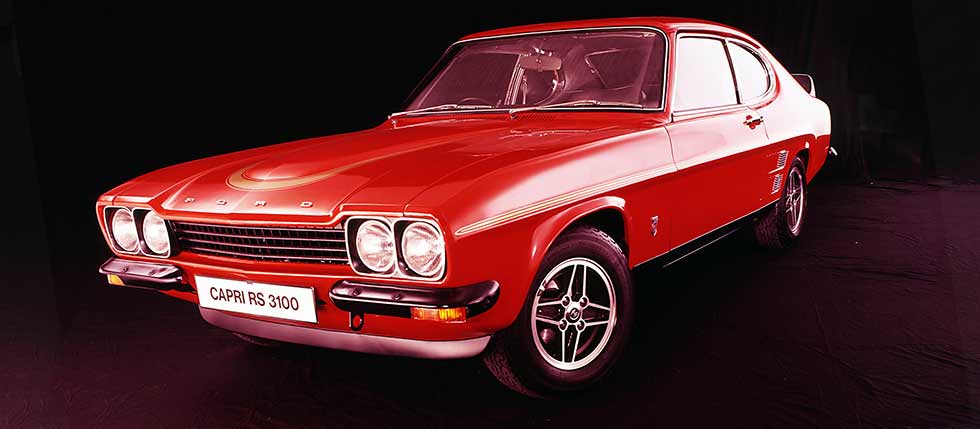
ESCORT RS1700T, 1980
Based on the Escort Mk3, this was a rear-wheel-drive Group B rally car with a longitudinally mounted BDT (a turbocharged BDA, effectively) engine. It wasn’t a success, so it was shelved in favour of the RS200.
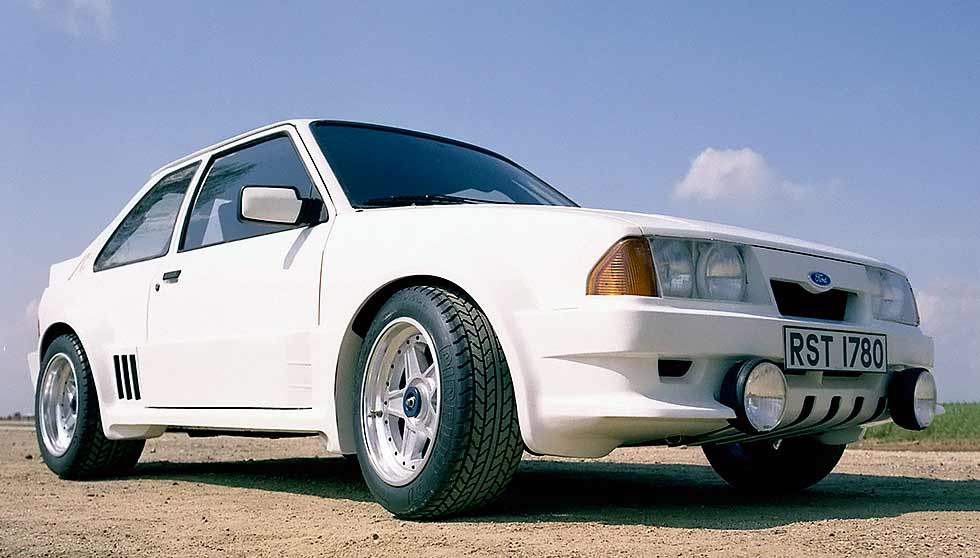
RS200, 1984
Ford’s next Group B rally machine was a purpose-designed two-seater with four-wheel drive, a mid-mounted BDT engine and a chassis/body unit built under contract by Reliant. After the demise of Group B, influenced in part by a couple of high-profile RS200 accidents, the remaining cars in the production run of 200 became luxuriously trimmed, but still very unrefined, road cars.
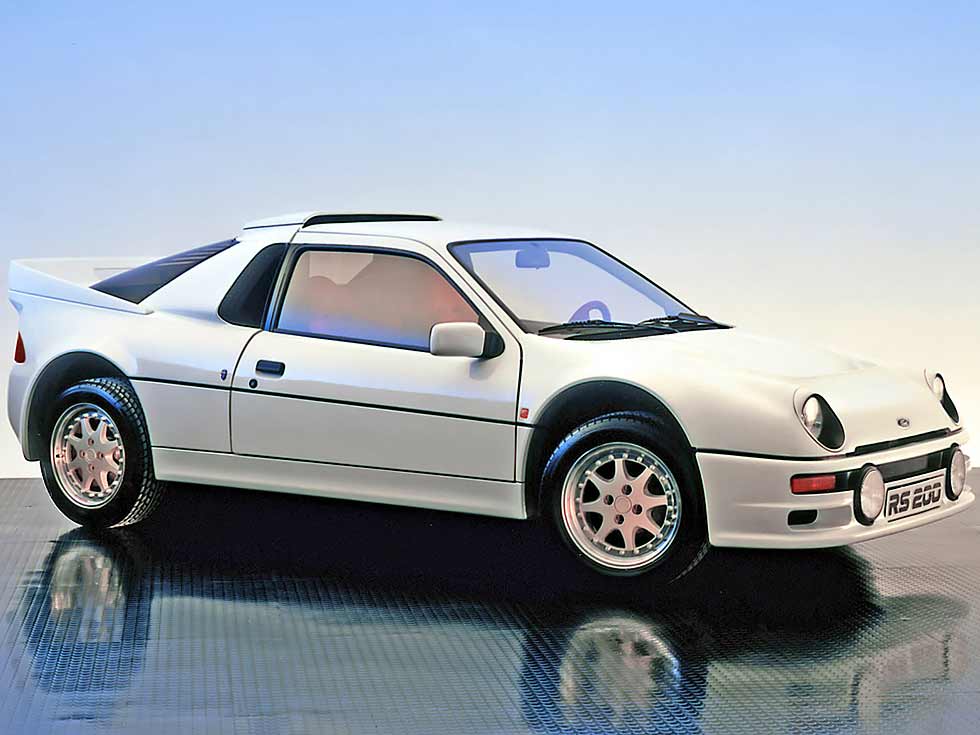
SIERRA RS COSWORTH, 1986
Originally built in the Sierra’s three-door hatchback body, the breed morphed into a four-door saloon in the Sapphire body, gaining four-wheel drive towards the end of its life. The RS500 ‘evolution’ version of the three-door, with a bigger turbo and four extra injectors (unused in the road version) is much prized today. In Group A saloon racing the Sierra Cosworths were unbeatable for a time.
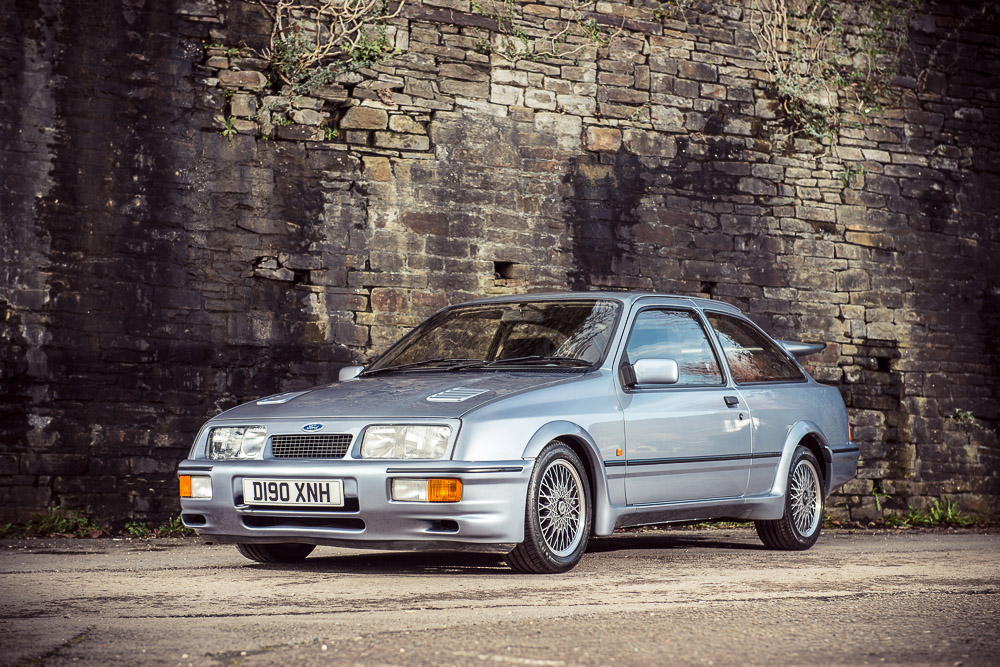
FIESTA RS TURBO and RS1800, 1990
The Fiesta XR2i was hopeless, so Ford’s second attempt at matching leading French rivals involved a turbo and the expert hand of SVE. It was rough, ready and prone to erratic torque steer, and it did not sell well. In 1992 the turbo engine was replaced by a 1.8-litre Zetec 16-valve unit with similar power, less torque, less pace but more civility. It has disappeared from history almost without trace.

ESCORT RS2000 and RS2000 4×4, 1991
Not really true RS models, just a Mk4 Escort with a 2.0-litre, 16-valve engine, a pair of power bulges in the bonnet and opportunist naming. That said, the RS2000 was unrecognisably better to drive than lowlier Mk4 Escorts. Four-wheel drive arrived in 1993 with a visual facelift, Escort Cosworth-like rear suspension and a rearward torque bias. Engine remained transverse, however.
